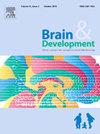运动神经元存活蛋白是评价利西泮治疗效果的最佳生物标志物
IF 1.3
4区 医学
Q4 CLINICAL NEUROLOGY
引用次数: 0
摘要
日本批准的治疗脊髓性肌萎缩症(SMA)的三种疾病改善药物的临床使用有所增加。因此,越来越需要生物标志物来评估治疗干预措施。方法25例患者(男:女=12:13)分别在用药前和用药后1、2、5、8、12个月进行评价。评估包括患者和护理者的Hammersmith功能运动量表扩展(HFMSE)、修订上肢模块(RULM)、尺神经和腓神经复合肌动作电位(CMAP)和脊髓性肌萎缩独立性量表上肢模块(SMAIS-ULM)问卷得分。血液检查和存活运动神经元(SMN)蛋白水平也被评估。结果在第5个月(p = 0.058和p = 0.003)、第8个月(p = 0.024和p = 0.016)和第12个月(p = 0.034和p = 0.046)时,患者的HFMSE和RULM评分均显著升高。与治疗开始前相比,8个月腓骨CMAP评分也有所增加(p = 0.038)。治疗1个月后,SMN蛋白水平升高(p = 0.001),并在整个观察期内保持不变。结论给药1个月后SMN蛋白水平中位数明显升高,但有一定波动。治疗5个月后,运动功能、CMAP和smis - ulm护理者得分均有所改善。SMN蛋白是监测和评估利西泮治疗SMA疗效的合适生物标志物。本文章由计算机程序翻译,如有差异,请以英文原文为准。
Survival motor neuron protein is the optimal biomarker for evaluating the risdiplam treatment
Background
The clinical use of three disease-modifying drugs approved in Japan for the treatment of spinal muscle atrophy (SMA) has increased. Therefore, there is an increasing need for biomarkers to evaluate therapeutic interventions.
Methods
Individuals were treated with risdiplam (25 patients, male:female =12:13) and evaluated before starting the medication and after 1, 2, 5, 8, and 12 months. Assessments included the Hammersmith Functional Motor Scale Expanded (HFMSE), Revised Upper Limb Module (RULM), compound muscle action potential (CMAP) of the ulnar and peroneal nerves, and spinal muscular atrophy independence scale upper limb module (SMAIS-ULM) questionnaire scores of the patient and caregiver. Blood tests and survival motor neuron (SMN) protein levels were also evaluated.
Results
The HFMSE and RULM scores increased significantly at 5 (p = 0.058 and p = 0.003, respectively), 8 (p = 0.024 and p = 0.016, respectively), and 12 months (p = 0.034 and p = 0.046, respectively). Peroneal CMAP scores also increased at eight months (p = 0.038) compared with those before treatment initiation. SMN protein levels were elevated after one month of treatment (p = 0.001) and were maintained throughout the observation period.
Conclusions
Median SMN protein levels increased significantly after one month of risdiplam administration with some fluctuations. After five months of treatment, motor function, CMAP, and SMAIS-ULM caregiver scores improved. SMN protein is an appropriate biomarker for monitoring and evaluating the efficacy of risdiplam treatment in SMA.
求助全文
通过发布文献求助,成功后即可免费获取论文全文。
去求助
来源期刊

Brain & Development
医学-临床神经学
CiteScore
3.60
自引率
0.00%
发文量
153
审稿时长
50 days
期刊介绍:
Brain and Development (ISSN 0387-7604) is the Official Journal of the Japanese Society of Child Neurology, and is aimed to promote clinical child neurology and developmental neuroscience.
The journal is devoted to publishing Review Articles, Full Length Original Papers, Case Reports and Letters to the Editor in the field of Child Neurology and related sciences. Proceedings of meetings, and professional announcements will be published at the Editor''s discretion. Letters concerning articles published in Brain and Development and other relevant issues are also welcome.
 求助内容:
求助内容: 应助结果提醒方式:
应助结果提醒方式:


